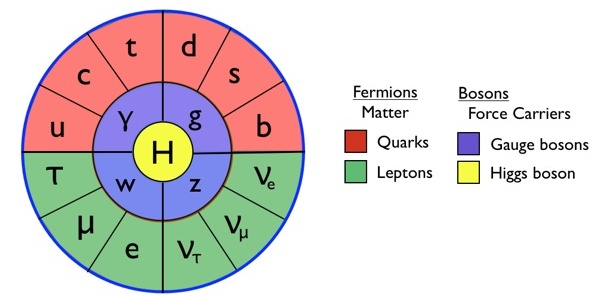
The Standard Model
The Higgs Boson
The Higgs boson was called the God particle because a generation of scientists accepted on faith that it existed. They had to build the huge and expensive
Large Hadron Collider (LHC) to find it.
Quantum theory explains the makeup of atoms. It shows how electrons fit around atomic nuclei made of protons and neutrons, which are made in turn of quarks,
which come in different colors and flavors, and it explains why different elements act in the way they do. The resulting Standard Model of particle physics
is now regarded as firm fact.
All of this quantum physics works perfectly on paper and proves itself time and time again in the lab and in the real world. But for a long time it was predicated
on the existence of what we now call the Higgs field, which worked in theory but seemed impossible to identify or observe in any normal way.
The Higgs field and its quantum counterpart the Higgs boson explain why some particles have mass, and indeed why any particles have mass at all. The role of the Higgs
is so fundamental that "the God particle" is an apt name. The boson had to exist in order for things to behave as theory said, and for a long time scientists had
to take its existence on faith for the Standard Model to work and to make sense.
The Higgs boson is the carrier particle for the Higgs field, which is a daunting way to say nothing has mass until it passes through the field and becomes surrounded
by a cloud of virtual particles, which give it mass.
The electrons and protons you heard about at school are theoretical ghosts until they pass through the Higgs field and bind with Higgs bosons. Field theory implies
that universal forces like gravity and electromagnetism are themselves real things, not just the superficial interaction of things we traditionally think of as
real.
In much the same way that pilots learn to regard the air as a fluid their aircraft are carving through, understanding the Standard Model with Higgs bosons means
regarding mass as a living thing, no less so than planet Earth and the people held onto its surface by gravity.
The Higgs boson is a carrier particle that exists only as long as it carries matter particles, providing them with mass and direction at the subatomic level. But
because the boson only exists while carrying the particles it binds to, it is impossible to see in any direct sense of the term. Smashing protons together and
observing their disintegration only provides us with faint traces of known particles being broken into more transient and mysterious entities.
Physicists have been seeking for decades to observe the Higgs boson. Conceiving, designing, and funding the LHC finally meant that their work could be applied in a
way that would lead to practical and tangible results. What they saw were effects and shadows confirming that what Peter Higgs and others had long imagined in
theory was really at work among the disintegrating protons. The discovery was groundbreaking news in the global science community.
The LHC is the biggest and most complex scientific instrument humans have ever built. Its main ring runs around an underground tunnel 27 km long and took thousands
of engineers from dozens of countries over a decade to build. The finished system has a staggering amount of computing power and requires massive amounts of
energy to operate.
All of this work was done with the sole goal of smashing protons together at 99.999% of the speed of light, billions of times per second, with the hope that the
data collected and fed to a global network of thousands of computers and supercomputers might reveal hints of particle science's own Mona Lisa smile, the
Higgs boson.
Everyone was certain it was there, but no one had ever seen it. After firing up the LHC and smashing huge numbers of protons together and taking vast amounts of data,
scientists were finally convinced that they had conclusively observed their "God particle" even though they had never seen it directly.
The giant underground machine with its miles of tunnels and thousands of computers is hugely intimidating. Some scientists speculated that creating a Higgs boson
under these conditions could instantly end the universe, because the Higgs field is universal and in constant perfect balance as it is. They imagined the
higher-energy particles they produced would then begin consuming everything around the site, indeed everything in the universe, in an instant and all-consuming
reaction.
Thankfully, that did not happen, but the events inside the LHC ring are nevertheless so extreme as to be mind-boggling. The process of colliding the protons requires
huge amounts of working space and driving energy to stage collisions that ultimately consume roughly the same energy as you snapping your fingers, focused into a
ridiculously tiny space.
This concentration of energy is what allows scientists to create particle interactions unseen since the Big Bang, but now in a controlled environment. It is difficult
to comprehend the full meaning of these particle interactions, but they promise to teach us much more about our universe and how its parts fit together.
Scientists found their evidence of the Higgs boson in 2012. Getting there involved shutting down the LHC for two years to upgrade and maintain its power systems and
replace many of its original computers with more powerful ones.
As this colossal microscope continues to work well, it may be upgraded again in the future. New experiments will reveal more about dark matter, black holes, and
other deep mysteries. We may even glimpse a new God particle.
|
|
|